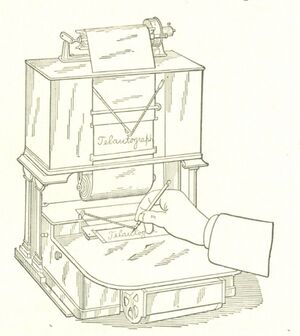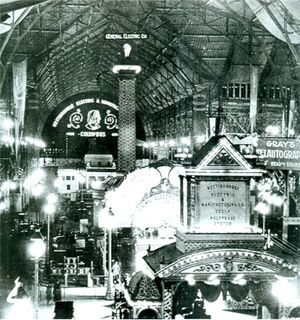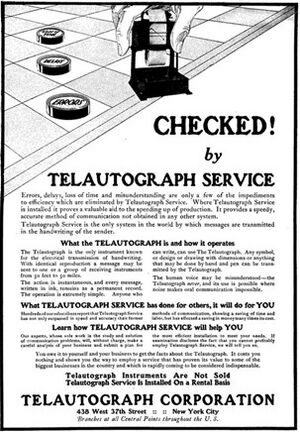Telautograph
This article was originally published in the February 2018 issue of IEEE-USA InSight
Technological progress and invention is not always a straight line, and often failures and defeats can unexpectedly lead to innovation. Elisha Gray, who on 14 February, 1876 had submitted a caveat to the patent office for a telephone just after Alexander Graham Bell’s patent was submitted, lost rights to the telephone after a lengthy legal dispute with Bell. A disillusioned Gray abandoned working on telephony, and instead focused his work in other areas, including ways to innovate using telegraphic technology., Gray spent the final phase of his career working on the telautograph, a device designed to transmit handwriting over electrical telegraph signals. The telautograph took input from a stylus connected to a series of mechanical levers and pivots, which were in turn attached to a telegraph transmitter. On the other end of the line, the receiver had a similar mechanical apparatus attached to a pen, which interpreted the telegraph signal and caused the pen to mimic the motions of the original stylus.
Gray was not the first person to conceive of the idea of transmitting handwriting over the telegraph. Early precursors include Bernhard Meyer’s 1865 autographic telegraph, Gustav Adolf Hasler’s 1873 Pantographe éléctrique, and Edward A. Cowper's autographic telegraph, patented in England in 1878 and publicized in contemporary newspapers and scientific magazines. James H. Robertson applied for a US patent for his autographic telegraph in 1885 and his company, the Writing Telegraph Company, had filed a series of patents through 1895. While the Robertson autographic telegraph was able to transmit legible handwriting, it did not have the ability to record spaces in between words or lines. Learning from his experience with the Bell dispute, Gray’s began working on his telautograph in 1887, and he immediately patented the device that year, despite the fact that early models were extremely limited in functionality. Legible handwriting required a degree of precision that was not possible in early attempts, and most transmissions were amorphous shapes that vaguely resembled the original. Gray continued to demonstrate the machine in public frequently to market the technology, and The Gray National Telautograph Company was formed in 1888. Improvements were made over the next several years and by 1890, the machine was precise enough where differences in two people’s handwriting could easily be distinguished from one another.
The 1893 Chicago World’s Fair was a major public demonstration of the system. Gray’s large amount of floor space and his prominent electrical sign were intended to attract a wide audience to his booth, which was well received by the public. Observers were impressed at how accurate the machine was, as the duplicated handwriting could not be differentiated from what was originally written.
Despite popular buzz surrounding the telautograph, it was slow to catch on commercially and was not typically installed for household use. The telautograph had trouble transmitting over long distances. Only transmissions between direct points were possible, as messages could not be relayed like the telegraph. The longest recorded transmission was from New York to Chicago in 1893, and in 1895 a detailed sketch along with a handwritten report was transmitted from Cleveland to Chicago. With these limitations, the technology was adopted for short to mid-range communications, often used to communicate from one building to another inside a complex.
The telautograph filled many niche business communication needs. One of the earliest major applications was by the military for fire control communication for coastal defense batteries in the 1890s. For most of the 20th century, banks and hospitals were the largest users of the telautograph. The telautograph was also used by the transportation industry for train and bus dispatches, and a telautograph was active in Grand Central Terminal until the 1960s. Additionally, the telautograph found use in office environments, weather reporting, hotels and manufacturing sites. Environments like steel mills, which were incredibly noisy to the point where telephone conversations could not be heard, adopted the telautograph.
In 1900, The Gray National Telautograph Company released a model designed by Foster Ritchie that was the standard in telautograph models for the next 30 years. At this time the company had filed 15 telautograph related patents. After Gray’s death in 1901, the Gray National Telautograph company expanded its commercial operations, and in 1915, the Gray National and Gray Electric companies merged, forming the Telautograph Corporation.
The Telautograph Corporation continued to make improvements on the telautograph, integrating electronic components throughout the 1940s and 1960s, and the company was bought by Arden/Mayfair in 1971. The last telautograph patent in the United States was filed in 1984, and in 1993 the company was purchased by Danka Industries, renamed Danka/Omnifax, and finally absorbed by Xerox in 1999. By the 1980s, the telautograph had been made obsolete by the fax machine, which was widely adopted in the office and in the home.
While Gray never achieved the same level of public recognition for his work as Bell, his persistence in developing the telautograph found him great financial success. Gray had sold the patent rights for a significant sum, and the much-improved 1900 design by Foster Richie allowed the technology to thrive long after Gray’s death, filling a unique communications need for nearly a century.
References and Further Reading
- Lewis Coe, The Telephone and Its Several Inventors: A History (Jefferson, NC: McFarland, 1995)
- Caroline Habluetzel, “The telautograph, scenes of handwriting and the changing cultural appreciation of physical authenticity” (PhD diss., McGill University, 2011)
- Anton A. Huurdeman, The Worldwide History of Telecommunications (Hoboken, NJ: Wiley-Interscience, 2003)
- William Maver, jr., American Telegraphy and Encyclopedia of the Telegraph: Systems, Apparatus, Operation (New York, NY: Maver Publishing, 1903)
- "The Telautograph in Steel Mills", The Iron Trade Review, June 17, 1909


